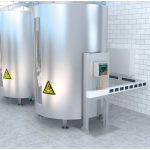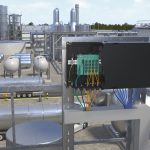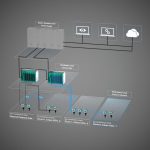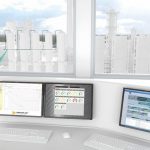With Ethernet-APL, the advantages of a fast Ethernet connection can finally be harnessed in the field of the process industry. Thus, a consistent data exchange between engineering, control or asset management systems is now possible. Inconsistencies caused by a device configuration that has not been transferred, for example when replacing a device, are now a thing of the past. Ethernet-APL is also an enabler for additional applications, such as NOA (Namur Open Architecture). NOA can be used, for example, to connect an optimisation programme for valves or maintenance tools without interfering with the existing control system structure. This means that the process industry will be able to respond much more flexibly and quickly to new and special requirements in process automation in the future.
The fleet management of the installed base of devices is also particularly interesting. With Ethernet APL, all relevant information from field devices can be monitored and evaluated over the entire life cycle and, above all, across plants. This includes configuration parameters, device identification or status diagnostics as well as correlation and comparison of process, engineering and maintenance data. Above all, the use of different data sources makes the decisive difference to the current situation.
Data from the field to the ERP system
Ethernet-APL is strictly defined as a physical layer and supports any Ethernet-based protocol, including those with real-time capabilities. Here, the two-wire Ethernet technology allows both communication and power supply to devices. The Ethernet-APL rail field switch from Pepperl+Fuchs provides the core element by connecting to instrumentation and transporting data transparently and without barriers. If desired, this data can be transferred all the way to the ERP system. The Ethernet-APL rail field switch can be installed on DIN rail in zone 2. The connections for field devices can be 200 m long and are intrinsically safe for zone 2 (Ex ic). With point-to-point connections only, the switch transmits power supply and communication. Such a topology is simple by design and therefore easy to operate and maintain. The network infrastructure is highly resistant to interference, even during connect and disconnect operations, which are often required during maintenance or device replacement.
Planning and installation of Ethernet-APL
Although it is a new technology, the switch has already been able to prove itself in practice. For example, Pepperl+Fuchs started an initial test of Ethernet APL with Bilfinger Engineering + Maintenance back in 2019. Within the test setup, the APL infrastructure prototypes available at the time from Pepperl+Fuchs were connected to a current process control system via Profinet. This was used to run through various use cases from the entire lifecycle of an automation system. These included installation, commissioning, the replacement of field devices, and redundancy transfers. At the same time, the effort required for migration projects from Profibus PA to Profinet via APL was examined. All test scenarios worked smoothly, which was impressive.
It was also demonstrated at the BASF test facility that Ethernet APL is very well suited as a physical layer in the field of process automation and as an enabling technology for higher-level applications. The interaction of the different technologies and functions, such as automatic reconfiguration after a device replacement or redundancy switchover, have meanwhile also convinced other companies in the process industry.
Multi-generation solution
For Profibus PA instruments, the rail field switch offers a dual function for spurs and instruments. The field device can communicate either via fieldbus protocol Profibus PA or any Ethernet-based protocol e.g. Profinet. The switch detects the data signals and protocols. While the telegrams of Ethernet-based protocols simply pass through, the switch utilises standardised profiles for Profibus PA, which enables seamless integration of cyclical and configuration data according to the PA Profile into engineering and control systems. These solutions are particularly interesting when not all devices with APL ports are available in the initial phase of APL technology, as one infrastructure can operate both technologies at the same time. The same applies to plant modernisation, where the investment in instrumentation needs to be protected.
More and more users wonder how the path to digitisation can succeed given the large installed base of 4…20 mA devices. To be sure, there is a lot of interest in the data that lies dormant in current instrumentation. However, the way to get at this data is not always straightforward. Here, remote IO systems offer a good way to access information from 4…20 mA devices.
For this purpose, the Profinet gateway for the LB and FB remote I/O systems is developed. In addition to the conventional Profinet functionality, the gateway offers full access to all connected Hart devices and thus forms a bridge between the field level and Ethernet-based network architectures. Up to 80 field devices are individually addressed by one Hart modem each and therefore communicate without any time delay. In addition to the actual sensor measurements, the Profinet gateway cyclically transmits the secondary measured values provided in Hart auxiliary variables every 500 ms. For example, a pressure transmitter not only supplies the current process value, but also the temperature of the medium.
Securely packed in certified enclosures
The role of enclosures in digital plant has occasionally been underestimated. These must meet all necessary standards and be specifically approved as a complete solution for hazardous areas. Pepperl+Fuchs configures turnkey enclosure solutions that can be installed with minimal effort in hazardous areas, with various components as complete functional units for Ethernet, fieldbus and remote I/O.
Two completely new enclosure series, made of plastic or stainless steel depending on requirements, are characterised by maximum flexibility and numerous well thought-out details. For example, the switch size has already been taken into account and extra-deep housings have been designed for easy connection with sufficient cable radius for future Ethernet APL applications. They are also designed to meet the special requirements of Ex e and Ex i and are thus ideally suited to the special challenges in the process sector.
Ethernet-APL is well on its way to becoming the data highway of the future. Existing rural roads can be perfectly integrated into this road network. With its expertise, Pepperl+Fuchs supports planners and users in selecting the right path into the digital world. This reduces risks, cuts costs, and shortens project planning, installation, and commissioning times.
Pepperl+Fuchs SE, Mannheim, Germany
Hall 9, Booth D76
Interview: Ethernet-APL in practice
The BASF test facility is considered a showcase. Have other companies already expressed interest?
Michael Kessler: There is a lot of interest. Many customers are seriously considering Ethernet-APL. Curious about how Ethernet-APL works in practice, a European customer recently asked Pepperl+Fuchs for an impromptu plugfest. There, a wide variety of field devices were put on the table, including some with an old Profibus PA profile. Together with the control system manufacturer, the integration was started. The integration was so straightforward that the user was impressed. Even the older field devices register „personally“. The connection via Ethernet APL was much easier than expected. But it is not just interest, we also get orders.
What will be the biggest challenges in
the process industry when switching to a digital plant?
Kessler: Accessing the large amount of data that exists in a plant without having to spend an endless amount of time and effort on it. Ethernet is the solution for this because it is the only way to achieve seamless, protocol-independent communication. Ethernet-APL brings the integrated communication to the field devices, where the data originates. This creates opportunities to simplify processes and to redesign workflows in a new and more robust way. To pick just one aspect: The supplier provides the field device with a measuring point designation that has been specified by the engineering system. During commissioning, the control system automatically compares the device fleet from engineering with what is installed. The advantages for the user are immense. Manual errors during commissioning are avoided. This not only saves money because it is less work, but the plant can also go into operation sooner.
What are the next steps with
Ethernet-APL?
Kessler: The technology is ready. First products are available. We can integrate Profibus-PA devices into the APL infrastructure. Our Remote I/O is a perfect addition with which to integrate all traditional signals. So nothing stands in the way of digitisation in the field. We at Pepperl+Fuchs are sure that many users will choose this path instead of equipping plants that are expected to run for another 50 years or more with technology that is 40 years old.
Ethernet-APL is a stable platform for a variety of future innovations. It provides field devices with more power that will be used for new functionality not possible today. New open and unified protocols for more pervasiveness will find their way into process automation. Ethernet-APL field devices will be certified for safety applications. Relying on Ethernet-APL today brings immediate benefits to all stakeholders and creates the basis to benefit from these innovations in the future.













